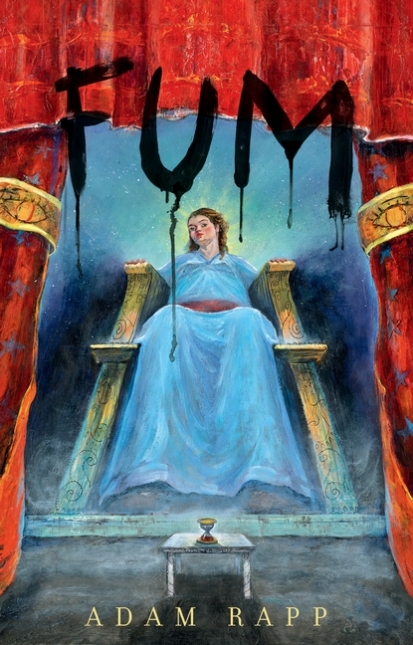Fum
- By Adam Rapp
- Candlewick Press
- 416 pp.
- Reviewed by Adrienne Kisner
- May 16, 2018
Just how monstrous is a rather large teenage girl?

The main character in Fum, a young-adult novel that reads part contemporary realistic, part fairytale, is 7’4”, 287-lb. Corinthia Bledsoe. At 11, Corinthia developed a tumor on her pituitary gland that caused her to grow and grow. Now toilets crack from her weight. School desks shatter under her statuesque frame.
Almost everyone who sees her, including (and especially) her own mother, balks at her size. The physical space Corinthia inhabits is often more of a character in the story than Corinthia the human being.
“Yes, she is a giant,” author Adam Rapp writes. “She is gigantic.”
As if Corinthia’s magnitude alone was not enough to set her apart, she begins to experience startlingly accurate portents of events to come.
She foresees tornadoes that will destroy parts of Lugo Memorial High. She predicts a flock of geese that will devour its sports fields. She tries to warn everyone, but that just yields her further visits to the guidance counselor and heightened scorn from her small-minded town.
The stories of several other characters unfold around Corinthia through an intoxicating third-person, present-tense narration. Corinthia’s mother, Marlene, represses her disgust and rage at her own life through exercise, chronic binge shopping, and attendance at a support group for parents of children with “physical deformities.”
Corinthia’s father, Brill, a kind but ineffectual man, muddles through his days unable to engage authentically with anything around him. Corinthia’s popular, well-muscled brother, Channing, goes missing without explanation.
Corinthia herself pursues an inappropriate relationship with a caricature of an older, black ex-convict. An inexplicably tangential plotline weaves the diary of freshman Billy Ball into the narrative, wherein he records injustices against people like him and Corinthia wrought by the “average” people around them.
Rapp’s lush prose shines brightest in his intricate, visceral descriptions. Corinthia screams at her classmates:
“The sky will turn brown, green, yellow. Confused crows will skitter across the ground like lost rickety men. Dogs will scamper in circles, their faces crazed. Cats will slink backward down the trunks of ancient sycamores. Trees will lean away from the sky. The air will grow as thick as maple.”
Most of the book is like that — words pull the reader into a deep, dark place full of beauty so confounding you often don’t realize the implicit horror of it right away.
Because there is horror here in Corinthia’s surreal world where nature is turning in on itself. Actual wolves stalk the woods beyond the small town’s manicured lawns. Wind and wing beat against the façade of normal lives, stealing children from families. Pain and grief and teen angst take physical form and assault everyone. No one, not even Corinthia’s beautiful brother, is able to escape the grotesque specter of dread both existential and physical.
In particular, one fear expressed in the book — that of a large female body — begs the question: Why is a seven-plus-foot girl really that shocking? Sure, Corinthia is tall, but her proportions would give her nearly a normal BMI, if such metrics even matter. Solid porcelain (of a standard toilet) should be able to hold someone five times her size. So, too, should a well-made wooden desk chair or standard-issue sofa.
That she is such a burden on the craftsmanship of objects might be part joke, part winking commentary on what it means to be “average,” but it reads as cruel as it is nonsensical.
Rapp also takes great pains — pages and pages of pains — to describe Corinthia’s bodily functions. Eating, drinking, urinating, menstruating — all are exaggerated to point out what a monster she appears to everyone. This could be an attempt to say that all bodies are strange and grotesque in some way, but that effort, too, ultimately fails. Corinthia is never a person — she is an object, a spectacle at which the reader gawks.
The book seems to want, at its heart, to critique the fragility of human relationships and encourage authentic connection. Corinthia’s favorite author tells her, “You must remember to be good to each other. No matter how bad things get. Don’t expect much from people, because humans are generally a very disappointing species. But nevertheless, you must try to give as much love as you can. Endure this life. And help others endure it, too. And fend off bitterness at every turn.”
This sage advice falls on drunken ears. That is the downfall of the book — an idea of what should be is drowned in a sea of dismal fixation on characters’ perceived deformity.
This ultimate treatment of Corinthia, of Billy, and even of Channing or any named character leaves the meandering plotlines little in the way of any hope or redemption.
An epilogue gives the reader a pretense that characters earn hard-won freedom, but, in reality, they remain bound in a time and space with despair instead of agency. Fum argues that this is the way for characters portrayed as such sad, ugly creatures in today’s world. Because of this, the strength of Rapp’s prose alone cannot recommend this book to teenage readers.
Adrienne Kisner is a writing instructor and contemporary YA author who holds an MFA in Writing for Children and Young Adults from Vermont College of Fine Arts. Her debut young-adult novel, Dear Rachel Maddow, will be released from Feiwel and Friends/Macmillan next month.
